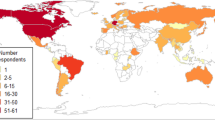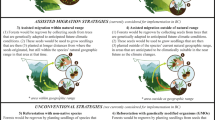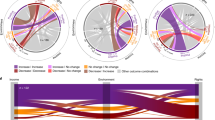Abstract
Forest practitioners play a key role in the development and implementation of novel interventions to respond to climate change in forests. However, little is known about how this group perceives climate change adaptation, let alone novel interventions. Understanding how practitioners evaluate and weigh the risks of climate change for forests, their levels and patterns of support for different climate-adaptive interventions, and their views about key factors to consider in implementing novel interventions, is essential for understanding how and why different forest jurisdictions are responding to climate change. Using a comparative case study of three Canadian provinces—Alberta, British Columbia, and Québec—we use an online survey to quantify the judgments of forest practitioners (n = 531) as above. We focus on assisted migration (AM), a climate-adaptive reforestation option that involves the intentional movement of tree species to more suitable areas within or outside of natural range based on climatic projections and genomic information. Overall, we find widespread support for AM across all three provinces, with more support for AM within as compared with outside of natural range. The central challenges of implementing AM are primarily perceived to be technical (e.g., climate projections, ecological data, and modeling), with other factors (e.g., economic viability, capacity and willingness of the forest sector, public opinion) being of secondary concern. While perceptions and patterns of support vary by province, our findings suggest that forest practitioners are embracing novel reforestation practices such as AM in response to new realities brought about by climate change.




Similar content being viewed by others
Notes
We also sought the opinions of professional biologists (e.g., ecologists, geneticists, plant biologists). However, the sample size of completed surveys by biologists was too small, and we do not present these results in this paper.
We collected a total of 593 completed surveys. Those jurisdictions that fell below the 30 response threshold include 23 in Ontario, 21 in New Brunswick, 6 in Newfoundland and Labrador, 5 in Nova Scotia, 4 in Saskatchewan, 2 in Manitoba, and 1 in Yukon.
Given that the focus of our survey was on climate-adaptive forest strategies, we acknowledge that the proportion of respondents who cited climate change adaptation as one of the most important reforestation outcomes may be overstated and that this result should be approached with caution.
References
Abbott G, Chapman CM (2018) Addressing the new normal: 21st century disaster management in British Columbia report and findings of the BC flood and wildfire review: an independent review examining the 2017 flood and wildfire seasons p 148. Retrieved from https://www2.gov.bc.ca/assets/gov/public-safety-and-emergency-services/emergency-preparedness-response-recovery/embc/bc-flood-and-wildfire-reviewaddressing-the-new-normal-21st-century-disaster-management-in-bc-web.pdf
ABCFP (Association of BC Forest Professionals), APB (Association of Professional Biology), CAB (College of Applied Biology), PIBC (Planning Institute of British Columbia) (2014) Professional Leadership in a Changing Climate: Joint Statement
Aitken SN, Whitlock MC (2013) Assisted gene flow to facilitate local adaptation to climate change annual review of ecology. Evolution, and Systematics 44:367–388. https://doi.org/10.1146/annurev-ecolsys-110512-135747
Aubin I, Garbe CM, Colombo S, Drever CR, McKenney DW, et al (2011) Why we disagree about assisted migration: ethical implications of a key debate regarding the future of Canada’s forests The Forestry Chronicle 87:755–765. https://doi.org/10.5558/tfc2011-092
BC MFLNRORD (2019a) Year in review-forest improvement and research management branch p 18. Retrieved from https://www2.gov.bc.ca/gov/content/industry/forestry/managing-our-forest-resources/tree-seed
BC MFLNRORD (2019b) Transitioning british columbia To climate based seed transfer: CBST and Assisted Migration p 2. Retrieved from https://www2.gov.bc.ca/gov/content/industry/forestry/managing-our-forest-resources/tree-seed/seed-planning-use/climate-based-seed-transfer
BC Wildfire Service (2018) Wildfire season summary. https://www2govbcca/gov/content/safety/wildfire-status/about-bcws/wildfire-history/wildfire-season-summary. Accessed Feb 11, 2019
Beaudoin A, Bernier PY, Guindon L, Villemaire P, Guo X J, et al. Mapping attributes of Canada’s forests at moderate resolution through kNN and MODIS imagery. Canadian Journal of Forest Research 44(5), 521–532. https://doi.org/10.1139/cjfr-2013-0401
Benito-Garzón M, Fernández-Manjarrés JF (2015) Testing scenarios for assisted migration of forest trees in Europe. New Forests 46:979–994. https://doi.org/10.1007/s11056-015-9481-9
Benomar L, Lamhamedi MS, Rainville A, Beaulieu J, Bousquet J et al. (2016) Genetic adaptation vs. ecophysiological plasticity of photosynthetic-related traits in young Picea glauca trees along a regional climatic gradient. Frontiers in plant science 7:48–48. https://doi.org/10.3389/fpls.2016.00048
Blair J, Czaja RF (2013) Designing surveys: a guide to decisions and procedures, Second edn. Sage Publications Inc., London
CAPF (2019) About CAPF: Mandate/Vision. https://www.capf.ca/mandate.html. Accessed 11 Feb 2019
Chilvers J, Kearnes M (eds) (2015) Remaking participation: science. Environment and Emergent Publics, Routledge
Colloff MJ, Lavorel S, van Kerkhoff LE, Wyborn CA, Fazey I et al. (2017) Transforming conservation science and practice for a postnormal world. Conserv Biol 31(5):1008–1017. https://doi.org/10.1111/cobi.12912
Conroy MJ, Peterson JT (2013) Decision making in natural resource management : a structured, adaptive approach. John Wiley & Incorporated, Hoboken
Conroy GC, Shimizu-Kimura Y, Lamont RW, Ogbourne SM (2019) A multidisciplinary approach to inform assisted migration of the restricted rainforest tree, Fontainea rostrata. PLoS ONE 14:e0210560–e0210521. https://doi.org/10.1371/journal.pone.0210560
D’Orangeville L, Duchesne L, Houle D, Kneeshaw D, Côté B et al. (2016) Northeastern North America as a potential refugium for boreal forests in a warming climate. Science 352:1452. https://doi.org/10.1126/science.aaf4951
Dilling L, Prakash A, Zommers Z, Ahmad F, Singh N, et al. (2019) (2019) Is adaptation success a flawed concept? Nat Clim Chang 9(8):572–574. https://doi.org/10.1038/s41558-019-0539-0
Dumroese RK, Williams MI, Stanturf JA, Clair JBS (2015) Considerations for restoring temperate forests of tomorrow: forest restoration, assisted migration, and bioengineering. New Forests 46:947–964. https://doi.org/10.1007/s11056-015-9504-6
Essl F, Dullinger S, Genovesi P, Hulme PE, Jeschke JM, et al. (2019) A conceptual framework for range-expanding species that track human-induced environmental change. Bioscience 69(11):908–919. https://doi.org/10.1093/biosci/biz101
Fettig CJ, Reid ML, Bentz BJ, Sevanto S, Spittlehouse DL et al. (2013) Changing climates, changing forests: a western North American perspective. Journal of Forestry 111:214–228. https://doi.org/10.5849/jof.12-085
Findlater K, Hagerman S, Kozak RA (2018) Stakeholder risk perceptions in climate-adaptive forestry: genomics for assisted migration in British Columbia. In: Society for Risk Analysis Europe, Östersund, Sweden, June 19 2018
Hagerman SM, Pelai R (2018) Responding to climate change in forest management: two decades of recommendations. Frontiers in Ecology and the Environment 16:579–587. https://doi.org/ezproxy.library.ubc.ca/10.1002/fee.1974
Hagerman SM, Satterfield T (2014) Agreed but not preferred: expert views on taboo options for biodiversity conservation, given climate change. Ecol Appl 24:548–559. https://doi.org/10.1890/13-0400.1
Hancock N, Gallagher R (2014) How ready are we to move species threatened from climate change? Insights into the assisted colonization debate from Australia. Austral Ecology 39:830–838. https://doi.org/10.1111/aec.12151
Heller NE, Hobbs RJ (2014) Development of a natural practice to adapt conservation goals to global change Conserv Biol 28:696–704 doi:https://doi.org/10.1111/cobi.12269
Hewitt N, Klenk N, Smith A, Bazely DR, Yan N, et al. (2011) Taking stock of the assisted migration debate Biological Conservation 144(11):2560-2572 https://doi.org/10.1016/j.biocon.2011.04.031
Hoegh-Guldberg O, Hughes L, McIntyre S, Lindenmayer DB, Parmesan C et al. (2008) Assisted colonization and rapid climate change Science 321:345–346 doi:https://doi.org/10.1126/science.1157897
Hotte N, Mahony C, Nelson H (2016) The principal-agent problem and climate change adaptation on public lands Glob Environ Change 36:163–174 doi:https://doi.org/10.1016/j.gloenvcha.2016.01.001
Jasanoff S (2011) Designs on nature, science and democracy in Europe and the United States. Princeton University Press, Princeton
Kareiva P, Fuller E (2016) Beyond resilience: how to better prepare for the profound disruption of the Anthropocene Global Policy 7:107–118 doi:https://doi.org/10.1111/1758-5899.12330
Keenan RJ (2015) Climate change impacts and adaptation in forest management: a review annals of Forest science 72:145-167 doi:https://doi.org/10.1007/s13595-014-0446-5
Klenk NL (2015) The development of assisted migration policy in Canada: an analysis of the politics of composing future forests Land Use Policy 44:101-109 doi:https://doi.org/10.1016/j.landusepol.2014.12.003
Klenk NL, Larson BMH (2015) The assisted migration of western larch in British Columbia: a signal of institutional change in forestry in Canada? Glob Environ Change 31:20–27. https://doi.org/10.1016/j.gloenvcha.2014.12.002
Kurz WA, Stinson G, Rampley GJ, Dymond CC, Neilson ET (2008) Risk of natural disturbances makes future contribution of Canada's forests to the global carbon cycle highly uncertain. Proc Natl Acad Sci U S A 105:1551–1555. https://doi.org/10.1073/pnas.0708133105
Laatsch J, Ma Z (2015) Strategies for incorporating climate change into public forest management Journal of Forestry 113:335-342 doi:https://doi.org/10.5849/jof.14-128
Larson BMH (2007) Who’s invading what? Systems thinking about invasive species Canadian Journal of Plant Science 87:993–999
Lavrakas PJ (ed) (2008) Encyclopedia of survey research methods. Thousand Oaks, California doi:https://doi.org/10.4135/9781412963947
Luckert MK, Haley D, Hoberg G (2011) Policies for sustainably managing Canada’s forests: tenure, stumpage fees, and forest practices. UBC Press, Vancouver
MacLachlan IR, Yeaman S, Aitken SN (2017) Growth gains from selective breeding in a spruce hybrid zone do not compromise local adaptation to climate Evolutionary Applications 11:166–181 doi:https://doi.org/10.1111/eva.12525
Mildenberger M, Howe P, Lachapelle E, Stokes L, Marlon J et al. (2016) The distribution of climate change public opinion in Canada PLoS ONE 11:e0159774. https://doi.org/10.1371/journal.pone.0159774
Millar CI, Stephenson NL, Stephens SL (2007) Climate change and forests of the future: managing in the face of uncertainty. Ecol Appl 17:2145–2151. https://doi.org/10.1890/06-1715.1
Morecroft MD, Duffield S, Harley M, Pearce-Higgins JW, Stevens N et al. (2019) Measuring the success of climate change adaptation and mitigation in terrestrial ecosystems. Science 366:eaaw9256-9257 doi:https://doi.org/10.1126/science.aaw9256
Moser SC, Boykoff MT (2013) Successful adaptation to climate change: linking science and policy in a rapidly changing world. Routledge, London
Mueller JM, Hellmann JJ (2008) An assessment of invasion risk from assisted migration. Conserv Biol 22:562–567. https://doi.org/10.1111/j.1523-1739.2008.00952.x
Muller JJ, Nagel LM, Palik BJ (2019) Forest adaptation strategies aimed at climate change: assessing the performance of future climate-adapted tree species in a northern Minnesota pine ecosystem Adaptation of Forests and Forest Management to Changing Climate 451:117539
Natural Resources Canada (2018) The state of Canada’s forests. Annu Rep 2018
Natural Resources Canada (2019) Mountain pine beetle. nrcan.gc.ca/our-natural-resources/forests-forestry/wildland-fires-insects-disturban/top-forest-insects-diseases-cana/mountain-pine-beetle/13381. Accessed Dec 29 2019
Neff MW, Larson BMH (2014) Scientists, managers, and assisted colonization: four contrasting perspectives entangle science and policy Biological Conservation 172:1-7 doi:https://doi.org/10.1016/j.biocon.2014.02.001
Nelson HW, Williamson TB, Macaulay C, Mahony C (2016) Assessing the potential for forest management practitioner participation in climate change adaptation Adaptation of Forests and Forest Management to Changing Climate 360:388–399 doi:https://doi.org/10.1016/j.foreco.2015.09.038
Park A, Talbot C (2018) Information underload: ecological complexity, incomplete knowledge, and data deficits create challenges for the assisted migration of forest trees Bioscience 68:251–263
Pedlar JH et al. (2012) Placing forestry in the assisted migration debate Bioscience 62:835–842 doi:https://doi.org/10.1525/bio.2012.62.9.10
Pelai R (2019) Whose expertise counts? assisted migration and the politics of knowledge. Master’s Thesis. University of British Columbia, Vancouver
Peterson St-Laurent G, Hagerman SM, Kozak RA (2018) What risks matter? Public views about assisted migration and other climate adaptive reforestation strategies Clim Change 151:573–587 doi:https://doi.org/10.1007/s10584-018-2310-3
Peterson St-Laurent G, Hagerman S, Findlater KM, Kozak R (2019) Public trust and knowledge in the context of emerging climate-adaptive forestry policies. J Environ Econ Manag 242:474–486. https://doi.org/10.1016/j.jenvman.2019.04.065
Price DT, Alfaro RI, Brown KJ, Flannigan MD, Fleming RA, et al. (2013) Anticipating the consequences of climate change for Canada’s boreal forest ecosystems Environmental Reviews 21(4):322–365 https://doi.org/10.1139/er-2013-0042
Prober SM, Doerr VAJ, Broadhurst LM, Williams KJ, Dickson F (2019) Shifting the conservation paradigm: a synthesis of options for renovating nature under climate change Ecological Monographs 89:e01333–e01323 doi:https://doi.org/10.1002/ecm.1333
Rea LM, Parker RA (2014) Designing and conducting survey research : a comprehensive guide. Jossey-Bass, San Francisco
Sousa-Silva R, Verbist B, Lomba N, Valent P, Suškevičs M et al (2018) Adapting forest management to climate change in Europe_ linking perceptions to adaptive responses Forest Policy and Economics 90:22–30 https://doi.org/10.1016/j.forpol.2018.01.004
Statistics Canada (2019) Gross domestic product (GDP) at basic prices, by industry, provinces and territories. https://www150.statcan.gc.ca/t1/tbl1/en/tv.action?pid=3610040201&pickMembers%5B0%5D=2.2&pickMembers%5B1%5D=3.17
Stein BA, Shaw MR (2013) Biodiversity conservation for a climate-altered future. In: Moser SC, Boykoff MT (eds) Successful adaptation to climate change: linking science and policy in a rapidly changing world. Routledge, London, UK, pp 50–66
Ste-Marie C (2014) Adapting sustainable forest management to climate change: a review of assisted tree migration and its potential role in adapting sustainable forest management to climate change. Canadian Council of Forest Ministers, Ottawa
Talley JL, Schneider J, Lindquist E (2016) A simplified approach to stakeholder engagement in natural resource management: the five-feature framework Ecol Soc 21:art38-11 doi:https://doi.org/10.5751/ES-08830-210438
Velasquez-Manoff M (2019) Can humans help trees outrun climate change? The New York Times
Wang T, Campbell EM, O’Neill GA, Aitken SN (2012) Projecting future distributions of ecosystem climate niches: uncertainties and management applications Forest Ecology and Management 279:128–140 doi:https://doi.org/10.1016/j.foreco.2012.05.034
Webler T, Tuler S (2018) Four decades of public participation in risk decision making risk analysis: an official publication of the Society for Risk Analysis 73:903 doi:https://doi.org/10.1111/risa.13250
Wellstead A, Howlett M (2016) Assisted tree migration in North America: policy legacies, enhanced forest policy integration and climate change adaptation Scandinavian Journal of Forest Research 32:535-543 doi:https://doi.org/10.1080/02827581.2016.1249022
Winder R, Nelson E, Beardmore T (2011) Ecological implications for assisted migration in Canadian forests The Forestry Chronicle 87:731–744 doi:https://doi.org/10.5558/tfc2011-090
Yousefpour R, Hanewinkel M (2015) Forestry professionals’ perceptions of climate change, impacts and adaptation strategies for forests in south-west Germany Clim Change 130:273-286 doi:https://doi.org/10.1007/s10584-015-1330-5
Funding
This study was financially supported by funding from Genome Canada (CoAdapTree project no. 241 REF).
Author information
Authors and Affiliations
Corresponding author
Additional information
Communicated by Debbie Ley
Publisher’s note
Springer Nature remains neutral with regard to jurisdictional claims in published maps and institutional affiliations.
Supplementary information
ESM 1
(PDF 1204 kb)
Rights and permissions
About this article
Cite this article
Peterson St-Laurent, G., Kozak, R. & Hagerman, S. Cross-jurisdictional insights from forest practitioners on novel climate-adaptive options for Canada’s forests. Reg Environ Change 21, 4 (2021). https://doi.org/10.1007/s10113-020-01733-3
Received:
Accepted:
Published:
DOI: https://doi.org/10.1007/s10113-020-01733-3




